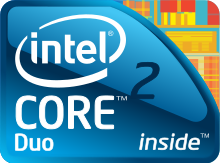
Back إنتل كور 2 Arabic Intel Core 2 Catalan Core 2 Czech Intel Core 2 Danish Intel Core 2 German Intel Core 2 Greek Intel Core 2 Spanish Core 2 Estonian Intel Core 2 Basque اینتل کور ۲ Persian
 Intel Core 2 Duo logo from 2009 to 2012 | |
| General information | |
|---|---|
| Launched | July 26, 2006 |
| Discontinued | June 8, 2012[1] |
| Marketed by | Intel |
| Designed by | Intel |
| Common manufacturer(s) |
|
| Performance | |
| Max. CPU clock rate | 1.06 GHz to 3.5 GHz |
| FSB speeds | 533 MT/s to 1.6 GT/s |
| Data width | 64 bits |
| Address width | 36 bits |
| Virtual address width | 48 bits |
| Cache | |
| L1 cache | 64 KB per core (32 KB data + 32 KB instructions) |
| L2 cache | Up to 12 MB |
| Architecture and classification | |
| Application | Desktop Mobile |
| Technology node | 65 nm to 45 nm |
| Microarchitecture | Core: Merom (65 nm) Penryn (45 nm) |
| Instruction set | x86-64 |
| Instructions | MMX, SSE, SSE2, SSE3, SSSE3, SSE4.1 |
| Physical specifications | |
| Transistors |
|
| Cores |
|
| Package(s) |
|
| Socket(s) |
|
| Products, models, variants | |
| Core name(s) |
|
| Product code name(s) |
|
| Model(s) |
|
| Variant(s) | |
| History | |
| Predecessor(s) | Pentium D (desktop) Intel Core Solo/Duo (mobile) |
| Successor(s) | Core i3/i5/i7 |
| Support status | |
| Unsupported | |
Intel Core 2 was a processor family encompassing a range of Intel's mainstream 64-bit x86-64 single-, dual-, and quad-core microprocessors based on the Core microarchitecture. The single- and dual-core models are single-die, whereas the quad-core models comprise two dies, each containing two cores, packaged in a multi-chip module.[2] The Core 2 range was the last flagship range of Intel desktop processors to use a front-side bus (FSB).
The introduction of Core 2 relegated the Pentium brand to the mid-range market, and reunified laptop and desktop CPU lines for marketing purposes under the same product name, which were formerly divided into the Pentium 4, Pentium D, and Core Solo/Duo brands.
The Core 2 processor line was introduced on July 27, 2006,[3] comprising the Duo (dual-core) and Extreme (dual- or quad-core CPUs for enthusiasts), and in 2007, the Quad (quad-core) and Solo (single-core) sub-brands.[4] Intel Core 2 processors with vPro technology (designed for businesses) include the dual-core and quad-core branches.[5]
Although Woodcrest processors are also based on the Core 2 architecture, they are available under the Xeon brand. From December 2006, all Core 2 processors were manufactured from 300-millimeter plates at Fab 12 factory in Arizona and at Fab 24-2 in County Kildare, Ireland.
- ^ "Product Change Notification #110665-00" (PDF). Intel Corp. June 6, 2011. Retrieved October 14, 2019.
- ^ "Intel Clovertowns step up, reduce power". TG Daily. Archived from the original on September 11, 2007. Retrieved September 5, 2007.
- ^ "Intel Unveils World's Best Processor". Intel. Archived from the original on April 3, 2007. Retrieved August 14, 2007.
- ^ "Intel to unify product naming scheme". TG Daily. Archived from the original on September 26, 2007. Retrieved August 6, 2007.
- ^ "Intel Centrino 2 with vPro technology and Intel Core2 processor with vPro technology" (PDF). Intel. Retrieved August 7, 2008.